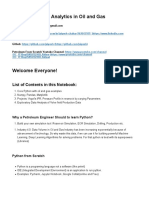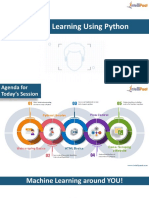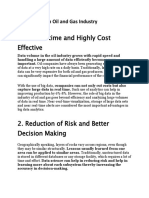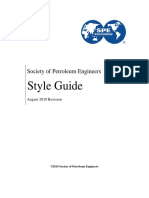ML For Oil and Gas Using Python
Uploaded by
Azeddine DjeML For Oil and Gas Using Python
Uploaded by
Azeddine DjeTHE ULTIMATE DATA-DRIVEN ADVENTURE
MR. NASHAT JUMAAH
11+ years experience in
oil and gas industry
SCAN +91 6205464268
TO JOIN
PEA info@peassociations.com
COMMUNITY www.peassociations.com
ABOUT THIS TRAINING
The "Machine Learning for Oil and Gas Using Python" course is
meticulously designed to equip you with the skills and expertise to
harness the potential of data and implement data-driven solutions
in the Oil and Gas sector.
Over the span of 2 months, you'll delve into a well-structured
curriculum that blends theory and hands-on projects to ensure
you're ready to tackle real-world challenges
SCAN +91 6205464268
TO JOIN
PEA info@peassociations.com
COMMUNITY www.peassociations.com
SKILLS GAINED
Get started with Python and Machine Learning
Learn the Basics of Python as an ML tool
Data Manipulation, Filtering, visualization, and processing
Machine Learning Implementation
Work with actual Oil and Gas Data
Learn from an instructor with 12 years of experience in
programming and technology
Create KPI Dashboard for Oil and Gas Field Operations
with ML implementation to derive insights and prediction
AUDIENCE
Reservoir Engineers
Production engineers
Chemical engineers
Drilling engineers
Geologists and petrophysics
AL and workover engineers
SCAN +91 6205464268
TO JOIN
PEA info@peassociations.com
COMMUNITY www.peassociations.com
WHAT YOU WILL GET
FROM JOINING
Access to Video Recordings on
a daily basis.
Study materials ppt, pdf
Many Oil and Gas Datasets.
Learn Python through the
Anaconda package
PREREQUISITES
No knowledge is required
A working laptop with Windows OS,
MacOS, or GNU Linux Distro
SCAN +91 6205464268
TO JOIN
PEA info@peassociations.com
COMMUNITY www.peassociations.com
PYTHON MODULE
This module will cover all Python basics to get started and feel
confident in writing code and maintaining future code bases.
MODULE 1: MODULE 2:
Introduction to Python for the Data container
oil and gas industry (Lists and Dictionaries)
Python tools and package options Operation on containers.
Data types and basic Python Introduction to loops
functions Introduction to Branching
Introduction to datacasting (IF Statements)
Introduction to string and string Mixing Lops and Branching
manipulation Introduction to User Functions
SCAN +91 6205464268
TO JOIN
PEA info@peassociations.com
COMMUNITY www.peassociations.com
PYTHON MODULE
This module will cover all Python basics to get started and feel
confident in writing code and maintaining future code bases.
MODULE 3:
Working with Arrays and Applying mathematics to them
Working with tabulated data
Basic Pandas functions for data manipulation
Introduction to visualization.
EDA – Exploratory Data Analysis
SCAN +91 6205464268
TO JOIN
PEA info@peassociations.com
COMMUNITY www.peassociations.com
MACHINE LEARNING MODULE
This module will introduce the trainee to machine learning concepts and
various uses and implementations, in this module user will learn how to
utilize Python as a tool for various ML-related projects
MODULE 4:
Processing Tabulated Data.
Data Filter, cleansing, and Outlier handing
Imputations and their methodologies
Feature Engineering
Plotting for ML (Distribution, Pair plots,
box, LMPlots, Heat)
Machine Learning Workflows
Putting Everything in place)
MODULE 5:
Introduction to machine learning Types
Introduction to Unsupervised Learning
K-Mean Clustering using Sklearn
Clustering Oil wells based on
petrophysical properties
Clustering Gas Wells Based on
Liquid Loading Index
Hierarchal clustering and Dendrogram.
Hierarchal Cluster Based Water Cut in
Oil Wells
SCAN +91 6205464268
TO JOIN
PEA info@peassociations.com
COMMUNITY www.peassociations.com
MODULE 6:
Introduction to Regression
Basics of Regressions using
NumPy Poly1d.
Introduction to Linear Regression
in SKlearn
Multivariate Regression in ML
Regression Applied to Oil and
Gas Production Prediction
Evaluation of Regression Models
Regression Sensitivity Analysis
using OVAT
Predicting Drilling Performance
Using Multilinear Regression
MODULE 7:
Introduction to classification problems
Classifications as applied to Oil and Gas Industry Problems.
Introduction to Logistic Regression.
Introduction to KNN.
Classifying Flow Stability in Oil Wells.
Comparing Decline Curve Analysis to
ML Regression
Introduction to Support Vectors (SVM)
Predicting Geomechanical Properties
using SVM
Shale Formation Simulation Classification
SCAN +91 6205464268
TO JOIN
PEA
info@peassociations.com
COMMUNITY www.peassociations.com
MODULE 8:
Introduction to Neural Networks
Introduction to deep learning
Introduction to fuzzy logic
Applications of NN in the oil and gas industry
Model Optimization
Dashboarding and ML Implementation
Notes on OOP approach and Production Grade Code.
SCAN +91 6205464268
TO JOIN
PEA
info@peassociations.com
COMMUNITY www.peassociations.com
You might also like
- Guidelines For Upstream Pre-Project Decommissioning EstimatesNo ratings yetGuidelines For Upstream Pre-Project Decommissioning Estimates58 pages
- Foreword 2021 Machine Learning and Data Science in The Oil and Gas IndustryNo ratings yetForeword 2021 Machine Learning and Data Science in The Oil and Gas Industry3 pages
- Otis, Haryott - How Low Should You Go - A Method To Calibrate Estimates of P99 Prospect Reserves (2006) PDFNo ratings yetOtis, Haryott - How Low Should You Go - A Method To Calibrate Estimates of P99 Prospect Reserves (2006) PDF29 pages
- Python For Reservoir Engineering and SurveillanceNo ratings yetPython For Reservoir Engineering and Surveillance2 pages
- Data Science & Machine Learning Applications in Oil & GasNo ratings yetData Science & Machine Learning Applications in Oil & Gas4 pages
- Python for Marketing Research and Analytics Wei Zhi 2024 scribd downloadNo ratings yetPython for Marketing Research and Analytics Wei Zhi 2024 scribd download24 pages
- DSM 700 - Installation and Calibration Check Procedure - 5664488 - 01 PDFNo ratings yetDSM 700 - Installation and Calibration Check Procedure - 5664488 - 01 PDF32 pages
- Advanced Applications of Python Data Structures and AlgorithNo ratings yetAdvanced Applications of Python Data Structures and Algorith410 pages
- Python: The Future Language of IT Industry100% (1)Python: The Future Language of IT Industry12 pages
- Stock Market Analysis With Python, Plotly, Dash, and PowerBI - by Edward Low - Feb, 2022 - DataDrivenInvestorNo ratings yetStock Market Analysis With Python, Plotly, Dash, and PowerBI - by Edward Low - Feb, 2022 - DataDrivenInvestor25 pages
- Scikit-Learn: Library For Machine Learning and Data Science With PythonNo ratings yetScikit-Learn: Library For Machine Learning and Data Science With Python11 pages
- Dokumen - Pub Machine Learning in Python For Dynamic Process SystemsNo ratings yetDokumen - Pub Machine Learning in Python For Dynamic Process Systems208 pages
- (Skiena, 2017) - Book - The Data Science Design Manual - 3No ratings yet(Skiena, 2017) - Book - The Data Science Design Manual - 31 page
- Genetic Algorithms in Oil Industry An OverviewNo ratings yetGenetic Algorithms in Oil Industry An Overview8 pages
- Cmps 396X Advanceddata Science: Fatima K. Abu Salem Exploratory Analysis Driving Visual Analysis With Automobile Data100% (1)Cmps 396X Advanceddata Science: Fatima K. Abu Salem Exploratory Analysis Driving Visual Analysis With Automobile Data113 pages
- BP's Statistical Review of World Energy Full Report 2009100% (5)BP's Statistical Review of World Energy Full Report 200948 pages
- Full Download Python Debugging For AI, Machine Learning, and Cloud Computing: A Pattern-Oriented Approach 1st Edition Vostokov PDF100% (5)Full Download Python Debugging For AI, Machine Learning, and Cloud Computing: A Pattern-Oriented Approach 1st Edition Vostokov PDF62 pages
- The Role of Carbon Capture and Storage To Achieve Net-Zero Energy SystemsNo ratings yetThe Role of Carbon Capture and Storage To Achieve Net-Zero Energy Systems10 pages
- 7 Geolog Drilling Optimization ServicesNo ratings yet7 Geolog Drilling Optimization Services10 pages
- Petrophysics-Driven Well Log Quality Control Using Machine Learning-2No ratings yetPetrophysics-Driven Well Log Quality Control Using Machine Learning-215 pages
- OceanofPDF - Com Data Science and Machine Learning - Daniel Asante OtcherNo ratings yetOceanofPDF - Com Data Science and Machine Learning - Daniel Asante Otcher322 pages
- Analytical and Interpretive Problems of Production Logging: JonesNo ratings yetAnalytical and Interpretive Problems of Production Logging: Jones6 pages
- Data Analytics in Reservoir Engineering Technical Report Open Comment VersionNo ratings yetData Analytics in Reservoir Engineering Technical Report Open Comment Version101 pages
- Spe-215029-Ms - Successful Deepwater MPD Application in Drilling and Cementing Through Depleted Formation With Wellbore Instability and Loss Circulation Challenge Offshore of SabaNo ratings yetSpe-215029-Ms - Successful Deepwater MPD Application in Drilling and Cementing Through Depleted Formation With Wellbore Instability and Loss Circulation Challenge Offshore of Saba12 pages
- Python Will Make You Rich in The Stock MarketNo ratings yetPython Will Make You Rich in The Stock Market8 pages
- Strategic Planning Oil Gas Industry Course Taster PDFNo ratings yetStrategic Planning Oil Gas Industry Course Taster PDF22 pages
- 15+ Hours of Practical Training On Power BI For Oil & Gas Zero To HeroNo ratings yet15+ Hours of Practical Training On Power BI For Oil & Gas Zero To Hero5 pages
- The Future Belongs to the Digital Engineer: Transforming the IndustryFrom EverandThe Future Belongs to the Digital Engineer: Transforming the IndustryNo ratings yet
- Python For Reservoir Engineering and SurveillanceNo ratings yetPython For Reservoir Engineering and Surveillance7 pages
- 01-Introduction To Python and Petroleum Data AnalysisNo ratings yet01-Introduction To Python and Petroleum Data Analysis14 pages
- (International Journal of The Sociology of Language) French and Spanish Colonial Policy in North Africa - Revisiting The Kabyle and Berber Myth-1No ratings yet(International Journal of The Sociology of Language) French and Spanish Colonial Policy in North Africa - Revisiting The Kabyle and Berber Myth-126 pages
- Survalent - Dynamic Voltage Regulation DVR Brochure PDFNo ratings yetSurvalent - Dynamic Voltage Regulation DVR Brochure PDF4 pages
- Master of Science in Engineering Management (MEM) ProgramNo ratings yetMaster of Science in Engineering Management (MEM) Program9 pages
- Chapter 9: Linear Momentum and CollisionsNo ratings yetChapter 9: Linear Momentum and Collisions18 pages
- (Projects) en Developing Pupil Competences Through ETwinningNo ratings yet(Projects) en Developing Pupil Competences Through ETwinning60 pages
- Grade 7 Fundamental Operation On Integers Addition of IntegersNo ratings yetGrade 7 Fundamental Operation On Integers Addition of Integers7 pages
- 09 9MA0 01 9MA0 02 A Level Pure Mathematics Practice Set 9 Mark SchemeNo ratings yet09 9MA0 01 9MA0 02 A Level Pure Mathematics Practice Set 9 Mark Scheme14 pages
- Thornton Et Al. - 2019 - Developing Athlete Monitoring Systems in Team SporNo ratings yetThornton Et Al. - 2019 - Developing Athlete Monitoring Systems in Team Spor27 pages
- Heat Conduction Fifth Edition Cotta Download PDF100% (2)Heat Conduction Fifth Edition Cotta Download PDF64 pages
- Illustrated Glossary of Geographic TermsNo ratings yetIllustrated Glossary of Geographic Terms12 pages
- Guidelines For Upstream Pre-Project Decommissioning EstimatesGuidelines For Upstream Pre-Project Decommissioning Estimates
- Foreword 2021 Machine Learning and Data Science in The Oil and Gas IndustryForeword 2021 Machine Learning and Data Science in The Oil and Gas Industry
- Otis, Haryott - How Low Should You Go - A Method To Calibrate Estimates of P99 Prospect Reserves (2006) PDFOtis, Haryott - How Low Should You Go - A Method To Calibrate Estimates of P99 Prospect Reserves (2006) PDF
- Data Science & Machine Learning Applications in Oil & GasData Science & Machine Learning Applications in Oil & Gas
- Python for Marketing Research and Analytics Wei Zhi 2024 scribd downloadPython for Marketing Research and Analytics Wei Zhi 2024 scribd download
- DSM 700 - Installation and Calibration Check Procedure - 5664488 - 01 PDFDSM 700 - Installation and Calibration Check Procedure - 5664488 - 01 PDF
- Advanced Applications of Python Data Structures and AlgorithAdvanced Applications of Python Data Structures and Algorith
- Stock Market Analysis With Python, Plotly, Dash, and PowerBI - by Edward Low - Feb, 2022 - DataDrivenInvestorStock Market Analysis With Python, Plotly, Dash, and PowerBI - by Edward Low - Feb, 2022 - DataDrivenInvestor
- Scikit-Learn: Library For Machine Learning and Data Science With PythonScikit-Learn: Library For Machine Learning and Data Science With Python
- Dokumen - Pub Machine Learning in Python For Dynamic Process SystemsDokumen - Pub Machine Learning in Python For Dynamic Process Systems
- (Skiena, 2017) - Book - The Data Science Design Manual - 3(Skiena, 2017) - Book - The Data Science Design Manual - 3
- Cmps 396X Advanceddata Science: Fatima K. Abu Salem Exploratory Analysis Driving Visual Analysis With Automobile DataCmps 396X Advanceddata Science: Fatima K. Abu Salem Exploratory Analysis Driving Visual Analysis With Automobile Data
- BP's Statistical Review of World Energy Full Report 2009BP's Statistical Review of World Energy Full Report 2009
- Full Download Python Debugging For AI, Machine Learning, and Cloud Computing: A Pattern-Oriented Approach 1st Edition Vostokov PDFFull Download Python Debugging For AI, Machine Learning, and Cloud Computing: A Pattern-Oriented Approach 1st Edition Vostokov PDF
- The Role of Carbon Capture and Storage To Achieve Net-Zero Energy SystemsThe Role of Carbon Capture and Storage To Achieve Net-Zero Energy Systems
- Petrophysics-Driven Well Log Quality Control Using Machine Learning-2Petrophysics-Driven Well Log Quality Control Using Machine Learning-2
- OceanofPDF - Com Data Science and Machine Learning - Daniel Asante OtcherOceanofPDF - Com Data Science and Machine Learning - Daniel Asante Otcher
- Analytical and Interpretive Problems of Production Logging: JonesAnalytical and Interpretive Problems of Production Logging: Jones
- Data Analytics in Reservoir Engineering Technical Report Open Comment VersionData Analytics in Reservoir Engineering Technical Report Open Comment Version
- Spe-215029-Ms - Successful Deepwater MPD Application in Drilling and Cementing Through Depleted Formation With Wellbore Instability and Loss Circulation Challenge Offshore of SabaSpe-215029-Ms - Successful Deepwater MPD Application in Drilling and Cementing Through Depleted Formation With Wellbore Instability and Loss Circulation Challenge Offshore of Saba
- Strategic Planning Oil Gas Industry Course Taster PDFStrategic Planning Oil Gas Industry Course Taster PDF
- 15+ Hours of Practical Training On Power BI For Oil & Gas Zero To Hero15+ Hours of Practical Training On Power BI For Oil & Gas Zero To Hero
- The Future Belongs to the Digital Engineer: Transforming the IndustryFrom EverandThe Future Belongs to the Digital Engineer: Transforming the Industry
- 01-Introduction To Python and Petroleum Data Analysis01-Introduction To Python and Petroleum Data Analysis
- (International Journal of The Sociology of Language) French and Spanish Colonial Policy in North Africa - Revisiting The Kabyle and Berber Myth-1(International Journal of The Sociology of Language) French and Spanish Colonial Policy in North Africa - Revisiting The Kabyle and Berber Myth-1
- Survalent - Dynamic Voltage Regulation DVR Brochure PDFSurvalent - Dynamic Voltage Regulation DVR Brochure PDF
- Master of Science in Engineering Management (MEM) ProgramMaster of Science in Engineering Management (MEM) Program
- (Projects) en Developing Pupil Competences Through ETwinning(Projects) en Developing Pupil Competences Through ETwinning
- Grade 7 Fundamental Operation On Integers Addition of IntegersGrade 7 Fundamental Operation On Integers Addition of Integers
- 09 9MA0 01 9MA0 02 A Level Pure Mathematics Practice Set 9 Mark Scheme09 9MA0 01 9MA0 02 A Level Pure Mathematics Practice Set 9 Mark Scheme
- Thornton Et Al. - 2019 - Developing Athlete Monitoring Systems in Team SporThornton Et Al. - 2019 - Developing Athlete Monitoring Systems in Team Spor











































































































